Hungerford Arcade, as our regular readers know, have a wonderful people come in and some have amazing stories. Bill Jackman is one of those people. He has an amazing collection of solid silver miniature chairs and kindly sent us this article which I hope you enjoy as much as I did.
ANTIQUE SILVER CHAIRS IN MINIATURE
Research has shown that silver miniature chairs, along with many other silver miniatures items, were made in abundance in Amsterdam (The Netherlands), from 1725-75.
The first dolls’ house was introduced into Holland from Germany in the 17th century and this accelerated the demand of silver chairs to furnish these small masterpieces of craftsmanship.
The main customers were the wealthy ladies of Dutch families and there was great rivalry to furnish their dolls’ house with the best silver furniture and equipment.
Large dolls’ houses had 12 rooms and all of which required at least one silver chair.
The production of silver toys in Amsterdam increased to satisfy the request internal and from abroad. The export of silver miniatures from the Netherlands continues today, though the numbers of silversmiths have vastly decreased.
The majority of silver chairs manufactured in the Netherlands were 60-70 mm in height. Yet a few examples were only 40 mm tall. Owing to the narrow gauge of the metal most of the Dutch chairs do not bears hallmark or maker’s mark or are left unmarked to avoid damages to the artifact.
Dutch chairs exported to the UK bear full sets of British silver import marks. This type of hallmarking has been mandatory since 1867 and continues to be requested in present days. In 1904 the familiar “F” mark used (1867-1904) in imported wares was discontinued and replaced by the use of a new set of Assay Office town marks.
Sometimes, misunderstanding the meaning of the import mark, less experienced dealers date the manufacture of a piece by the corresponding date-letter of the import mark. It may be happen that very old Dutch silver chairs, bearing only British hallmarking, are traded as artifacts made in the UK in the mid or late 20th century.
Ancient handmade Dutch silver chairs are easily recognised by their irregular workmanship. Usually, the ladder back supports do not match up as they have been hand cut and soldered in place.
In present days silver chairs are still manufactured in Holland by skilled workers, but, unfortunately, no new design is produced and most of the output is a mere replica the models of the past. This is a pity, as today production presents high levels of workmanship.
Silver chairs were made in Germany, mainly in Hanau, producing items of exquisite designs. Most of Hanau chairs carry an assortment of pseudo-hallmarks. These chairs are usually of fine quality, though many of them have been mass produced and stamped out by machine. Miniature chairs have been produced also in other countries, most of them with no hallmarks or makers marks. Some of the larger ones have been adapted as menu holders.
Most of the chairs in my collection, are, as far as I am aware, made of Sterling silver, except some of them which are of the lower 800/1000 silver fineness.
|
|
Two fine examples of German chairs and their marks.
Height 65mm, Weight 28 g each
|
|
Silver chair made in China in 1905 by Sing Fat and its mark.
Height 48mm, Weight 20 g each,
Silver chairs can be purchased on eBay, in antique fairs and, sometimes, in antique shops.
Good quality chairs are hard to find and expensive. Some of these early chairs can be found at Sotheby’s.
The majority of Dutch and German silver chairs appear to have woven hemp seating, though simulated leather seating are frequent.
|
|
A Dutch silver miniature of a tradesman weaving the seat on a chair with flax covering
|
|
Two spectacular Hanau silver armchairs, possibly mid 19th century. They are stamped with nude nymphs and elegant figures of ladies and gentlemen dressed in 18th century clothes. This was a very common feature on decoration of German silver miniatures.
Height 75mm, Weight 30 g each
|
|
A modern set of matching chairs and table with a cat on a chair looking greedily at fishes on the table. On the right hand leg can be seen a kitten playing with a ball. The silver has been anodised to give a gold effect.
The set has British hallmarks, maker’s initials SJR (possibly S.J. Rose & Son), Birmingham 1973. Total weight 100 g.
|
|
Two large silver chairs fitted with red velvet cushions, so they can be used as pin cushions.
The chair on the left was made by W. Cummins, 1902 and that on the right was made by J & W Deakin, Chester 1902. Their weigh is 100 g. each.
|
|
A selection of Dutch ladder back chairs c. 18-19th century. It is easy to see the irregularities in these handmade artifacts. Some of them bear hallmarks.
|
|
An anodised silver throne, known in Italy as “Savonarola chair”. A recent author’s acquisition
|
|
Four chairs from a set of six all with leather seats and back rests, with silver tassels front and sides. The country and maker are unknown. The style has been credited as being Art Nouveau, early 20th century.
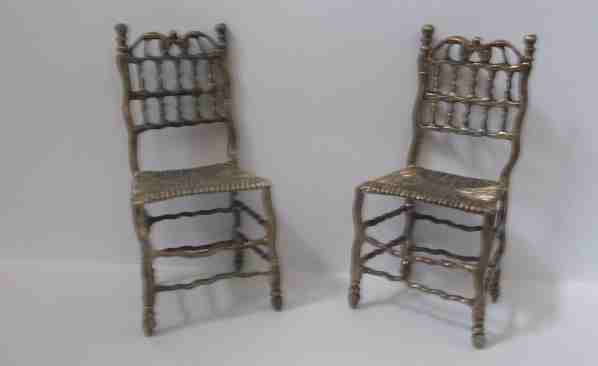
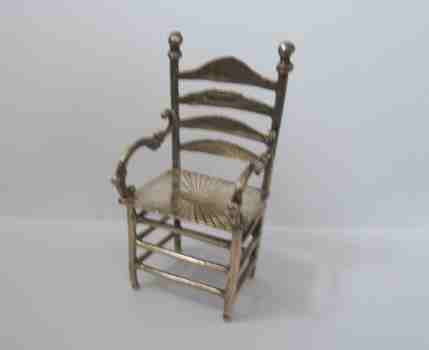
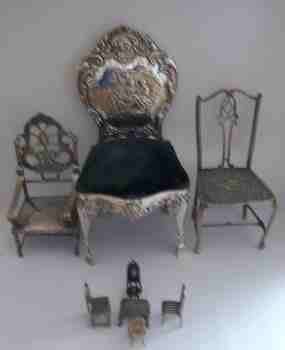
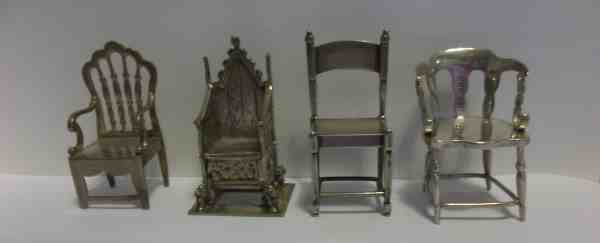
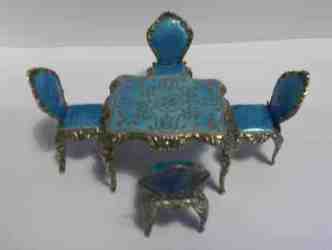
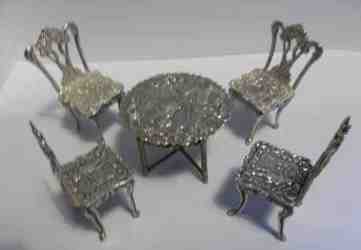
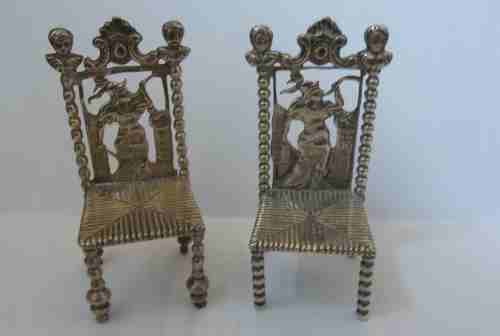
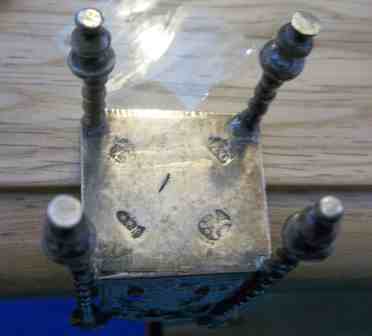
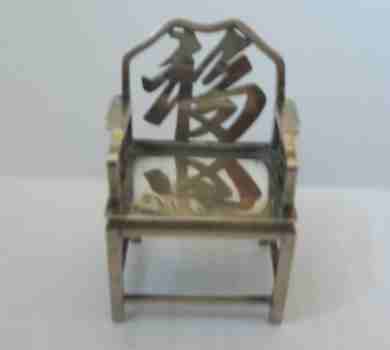
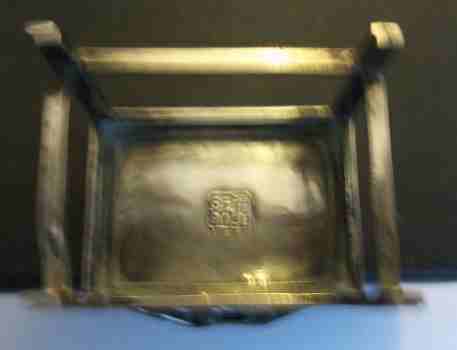
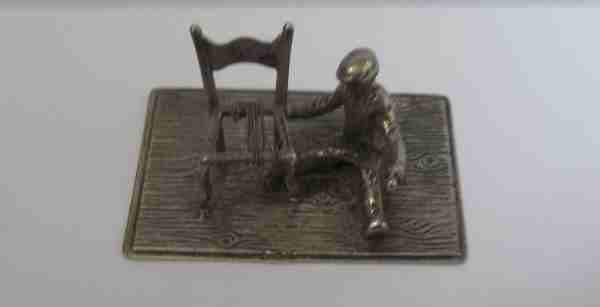
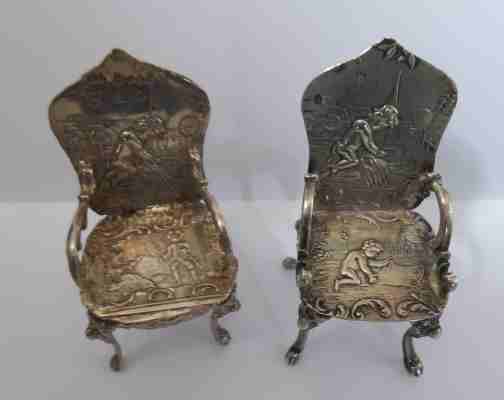
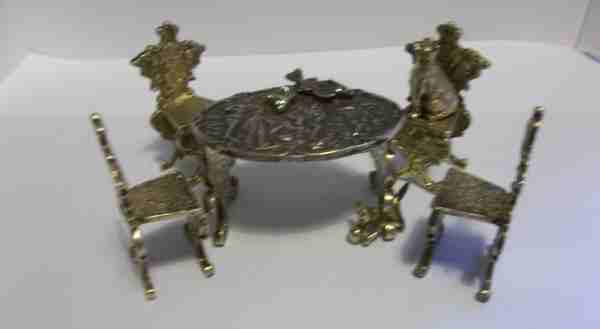
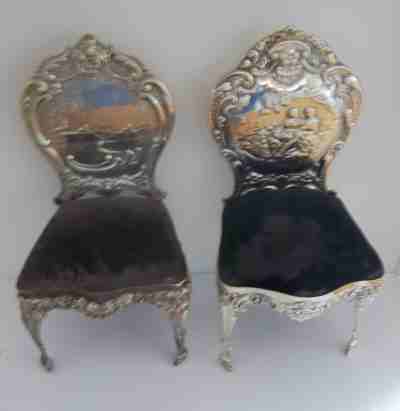
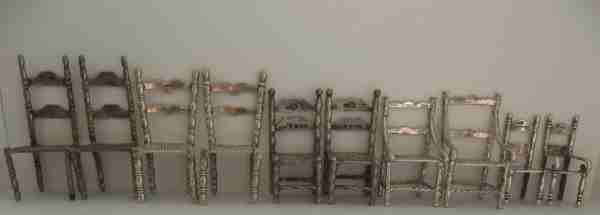
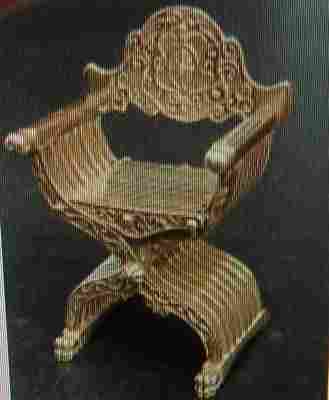
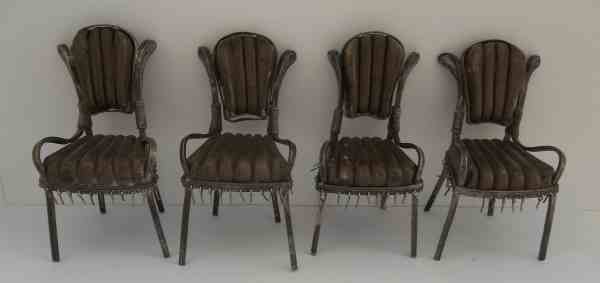

I was wondering if there was contact information for Bill Jackman? I am studying 17th century Dutch rush bottomed chairs and their relation to some American chairs in Maryland and Virginia. Thank you.
Hello Steve,
Sorry for the late response to you. I can give you Bill Jackman’s e-mail address which is:
bill@writerscramp.co.uk
Good luck with your studies.
Kindest regards,
Rita